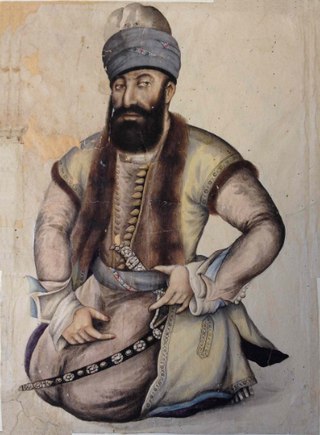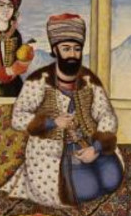Related Research Articles

Agha Mohammad Khan Qajar, also known by his regnal name of Agha Mohammad Shah, was the founder of the Qajar dynasty of Iran, ruling from 1789 to 1797 as Shah. Originally a chieftain of the Quwanlu branch of the Qajar tribe, Agha Mohammad Khan was enthroned as the king of Iran in 1789, but was not officially crowned until March 1796, having deposed Lotf Ali Khan of the Zand dynasty in 1794. Agha Mohammad Khan Qajar was famously the eunuch Monarch, being castrated as a young adult upon his capture by Adel Shah Afshar, and hence was childless. He was assassinated on 17 June 1797, and was succeeded by his nephew, Fath-Ali Shah Qajar.

Mohammad Karim Khan Zand was the founder of the Zand Dynasty, ruling from 1751 to 1779. He ruled all of Iran (Persia) except for Khorasan. He also ruled over some of the Caucasian lands and occupied Basra for some years.

The Zand dynasty was an Iranian dynasty, founded by Karim Khan Zand that initially ruled southern and central Iran in the 18th century. It later quickly came to expand to include much of the rest of contemporary Iran as well as parts of Iraq. The lands of present-day Armenia, Azerbaijan, and Georgia were controlled by khanates which were de jure part of the Zand realm, but the region was de facto autonomous. The island of Bahrain was also held for the Zands by the autonomous Al-Mazkur sheikhdom of Bushire.

The Karabakh Khanate was a khanate under Iranian and later Russian suzerainty, which controlled the historical region of Karabakh, now divided between modern-day Armenia and Azerbaijan. In terms of structure, the Karabakh Khanate was a miniature version of Iranian kingship. The administrative and literary language in Karabakh until the end of the 19th century was Persian, with Arabic being used only for religious studies, despite the fact that most of the Muslims in the region spoke a Turkic dialect.
Abol-Fath Khan Zand was the third Shah of the Zand dynasty, ruling from March 6, 1779, until August 22, 1779.

Jafar Khan Zand, was the seventh shah (king) of the Zand dynasty of Iran from 1785 to 1789. He was the son of Sadiq Khan Zand, who was removed from the throne in Shiraz by Ali Murad Khan, who had previously taken Isfahan for himself.

Sadeq Khan Zand, also known as Mohammad Sadeq, was the fourth Shah of the Zand dynasty of Iran from August 22, 1779 until March 14, 1781.

Ali-Morad Khan Zand was fifth ruler of the Zand dynasty of Iran, ruling from March 15, 1781, until February 11, 1785.
Mohammad Ali Khan Zand was the second shah of the Zand dynasty, ruling from March 6, 1779 until June 19, 1779.

The Nakhichevan Khanate was a khanate under Iranian suzerainty, which controlled the city of Nakhichevan and its surroundings from 1747 to 1828.
Mirza Abol-Qasem Qa'em-Maqam Farahani, also known as Qa'em-Maqam II, was an Iranian official and prose writer, who played a central role in Iranian politics in first half of the 19th-century, as well as in Persian literature.
Azād Khān Afghān, or Azād Shāh Afghān, was a Pashtun military commander and a major contender for supremacy in western Iran after the death of Nader Shah Afshar in 1747. Azad rose to power between 1752 and 1757, and had his power base in the Azarbaijan region. Azad was a contemporary of Ahmad Shah Durrani, the founder of the Durrani Empire.
Fath-Ali Khan Afshar, was a chieftain from the Afshar tribe of Urmia, and one of the four contenders for supremacy in Iran between 1751–1763. He was ultimately defeated and captured in February 1763 by one of the contenders, the Zand ruler Karim Khan Zand. The latter had Fath-Ali Khan executed the following year, in July 1764.

Hajji Ebrahim Shirazi, also known by his honorific title E'temad ol-Dowleh, was an Iranian statesman who served as the kalantar of the city of Shiraz during the late Zand era and later as the first grand vizier of Qajar Iran.

Shaykh Ali Khan Zand was a Zand nobleman, who was a close associate and prominent lieutenant of his cousin Karim Khan Zand. However, he later clashed with the latter, who had him blinded. He afterwards lived the rest of his life as an honored representative of the court, until a civil war occurred after Karim Khan's death in 1779, where Shaykh Ali Khan was killed by his cousin, Zaki Khan Zand.
Hossein Qoli Khan Qajar was the Qajar chieftain of the Qoyunlu branch from 1759 till his death in 1777 and brother of the founder of the Qajar dynasty of Iran Agha Mohammad Khan Qajar.
Hedayat-Allah Khan was a Gilaki prince, who was the semi-independent ruler of Gilan from 1753 to 1786.
Jamal al-Din Khan was the first khan of the Talysh Khanate under Iranian suzerainty, ruling from 1747 to 1786.
Mohammad Khan Zand was the son of Zaki Khan and the last claimant of the Zand dynasty in Iran during the 18th century..
Ali-Qoli Khan Qajar was a son of Mohammad Hasan Khan Qajar and half-brother of Agha Mohammad Khan Qajar, the founder of the Qajar dynasty of Iran. Unlike Agha Mohammad Khan's full brothers, Ali-Qoli Khan served loyally from the outset and supported, for around twenty years, Agha Mohammad Khan's conquest for control over all of Iran. Following Agha Mohammad Khan's assassination in 1797, he unsuccessfully tried to claim himself as his brother's rightful successor. Ali-Qoli Khan was eventually blinded and exiled by his nephew Baba Khan, who would ascend the Iranian throne as Fath-Ali Shah Qajar.
References
- ↑ Perry, John (2016). "Zand Dynasty". Encyclopædia Iranica, online edition. Retrieved 14 October 2018.
- ↑ The young children of Karim Khan Zand were neither designated Shah nor Wakil, but called in Persian sources "Khan", in European sources "King"; cf Perry, Zand Dynasty
- 1 2 3 W. William Bayne Fisher; P. Avery; G. R. G. Hambly; C. Melville (10 October 1991). The Cambridge History of Iran. Vol. VII. Cambridge University Press. p. 93. ISBN 978-0-521-20095-0 . Retrieved 28 July 2013.
- ↑ Kaveh Farrokh (20 December 2011). Iran at War: 1500-1988. Osprey Publishing. pp. 349–. ISBN 978-1-78096-221-4 . Retrieved 28 July 2013.